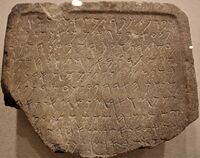نقش معصوب
| نقش معصوب Masub inscription | |
|---|---|
 النقش في اللوڤر | |
| أنشئت | 221 BC in أم العمد، المملكة الپطلمية |
| أُكتشفت | 1887 الشمالية Israel |
| الموقع الحالي | اللوڤر |
| اللغة | الفينيقية |
نقش معصوب هو نقش باللغة الفينيقية عُثر عليه في خربة معصوب، بالقرب من قرية البصة.[1] النقش هو من 222/21 ق.م.[2][1] مكتوب بالكتابة الفينيقية،[3] ويُعرف أيضاً بإسم KAI 19.[4]
تسلسل الملكية
يعتبر اللوڤر أن النقش جاء من أم العمد، لبنان، على بعد 6-7 كم إلى الشمال من خربة معصوب، على أساس الإشارة في النقش إلى معبد عشتارت؛ ومثل ذلك المعبد قد اكتشفته الحفريات في الموقع اللبناني.[2][5] This theory is contra the original provenance statement by Clermont-Ganneau and has also been recently contested by Friedman and Ecker, who see no reason to construe a new provenance and suggest that a second Astarte temple, a twin to the northern one from Umm al-Amad, was built at the southern entrance to the Ladder of Tyre pass, i.e. at or near Ma'sub, thus creating a ritual "bracket" for the pass.[2] In Dunand and Duru's catalogue of Umm al-Amad inscriptions, it is number iv.[6]
النقش
The inscription is given as:[7][8]
PLY
’Š
BN
H’LM
ML’K
MLK
-th (side), which the ʾElim (gods), the envoys of (the divine couple) Milk-
L‘ŠTRT
B’ŠRT
’L
ḤMN
to ʿAshtart, in the holy courtyard of the god Ḥammon
YM
ŠLŠ
ḤMŠM
ŠT
L‘M
[ṢR]
-phoi (literally "the gods-brothers"), (in the) three-(and)-fiftieth year of the people of [صور],
KM’Š
BN
’YT
KL
’ḤRY
[HMQ]
as also they built all of the other tem-
[DŠ]M
’Š
B’RṢ
LKN
LM
L[SKR]
-ples which are in the land, to be to them for [memory]
[WŠM
N‘M
‘D]
‘LM
[and good name for] eternity.
الهامش
- ^ أ ب Slouschz, Nahoum (1942). Thesaurus of Phoenician Inscriptions (in العبرية). Dvir. p. 44.
- ^ أ ب ت Friedman, Reuven; Ecker, Avner (2019). "Provenance and Political Borders: A Phoenician Inscription of the Hellenistic Period 'Strays' Across Modern Borders". Israel Exploration Journal. 69 (1): 60–72. Retrieved 29 March 2024.
- ^ stèle, Louvre website (in French). Accessed 28 March 2024.
- ^ C. Clermont-Ganneau (1887)."Deux inscriptions phéniciennes inédites de la Phénicie propre", Paris: E. Leroux.
- ^ TSSI, III, inscription 31
- ^ Dunand, M.; Duru, R. (1962). Oumm el-'Amed: une ville de l'époque hellénistique aux échelles de Tyr [Umm el-'Amed: A Hellenistic-period City from the Ladder of Tyrus] (in الفرنسية). Librairie d'Amérique et d'Orient. Retrieved 2021-12-11.
- ^ George Albert Cooke, A Text-book of North-Semitic Inscriptions: Moabite, Hebrew, Phoenician, Aramaic, Nabataean, Palmyrene, Jewish, 1903, no.10
- ^ Slouschz, Nahoum (1942). Thesaurus of Phoenician Inscriptions (in Hebrew). Dvir. pp. 44–45.
{{cite book}}: CS1 maint: unrecognized language (link)
المراجع
- CS1 العبرية-language sources (he)
- CS1 الفرنسية-language sources (fr)
- Short description is different from Wikidata
- Pages with interlinear glosses using two unnamed parameters
- اكتشافات أثرية في 1887
- نقوش فينيقية
- نقوش القرن الثالث ق.م.
- Near Eastern and Middle Eastern antiquities in the Louvre
- Phoenician steles
- KAI inscriptions
- Archaeological discoveries in Israel